9515 AN IMPORTANT CARVED ROCOCO CONSOLE TABLE RETAINING ITS ORIGINAL GILDED DECORATION German. Second Quarter Of The Eighteenth Century. Measurements: Height: 30 3/4″ (78 cm) Width: 54″ (137.2 cm) Depth: 23″ (58.4 cm)

Research
Of giltwood. The probably original white marble top supported on two profusely carved profoundly shaped legs headed by carved female busts, the frieze centered by a carved satyr mask, the legs joined by a carved stretcher centered by a pierced cartouche, the sides similarly carved in the rococo taste.
Marks:
Handwritten name Schneider to underside of marble top
Paper label to rear of Backrail: 596 Darmstadt, Frkfrt (Frankfurt?)
Old stencilled inventory number to inside of back rail 7448
Provenance:
Herr ? Knipschildt who was the wealthy Danish Managing Director of the East Asiatic Company which was based in Vladivostok prior to the Russian Revolution. The table was sold by his descendants.
It is a testament to the quality of design and execution of this table, and that of its pendant in the Museum of Applied Arts, Cologne* (figure 1), that it has been the subject of much conjecture as to its authorship among leading academics. This tour de force of rococo carving is perhaps one of the most dynamic, expressive and free-flowing examples of sculpted furniture made in mid-18th century Germany.
Its design is highly original and appears to owe little debt to previous console table prototypes. It is particularly notable for the opposing female busts that head each scrolling leg. Most unusually, they are carved completely in the round and represent two individual young females, one with a distinctive three-pointed cap and the other with naturalistically flowing hair. The figure bearing the cap is remarkable for being portrayed as apparently in the act of speech and projects the impression of a dialogue between the opposing busts.
This singular conceit places the table in a very small category of furniture that may be considered as true sculpture. The rococo ornament is no less remarkable and is imbued with a fire-like sense of movement, which is particularly apparent in the wavy stretcher. Throughout the table there is an unstudied freedom of execution, lending the piece a somewhat spontaneous quality.
In his seminal work, Die Kunst des deutschen Möbels (1970), Heinrich Kreisel speculated that the table in the Cologne museum mentioned above could be one of the few remaining specimens of the furnishings of Schloß Brühl, near Cologne, decorated between the years 1728-1740 by François Cuvilliés (1695-1768) for the Elector Clemens Augustus, Archbishop of Cologne and brother of the Elector Charles Albert of Bavaria, later Emperor Charles VII (1742-1745). The no less eminent scholar Georg Himmelheber was later to concur with this view, while Kreisel was to revisit the table with a changed attribution to the Rhine region. Having varied his theory, he felt that it could have been made for another of the castles in the region of Cologne belonging to the archbishop.
Elda Colsman also studied the Cologne table in her book Möbel, Gotik bis Jugendstil Die Sammlung im Museum für Angewandte Kunst, and was minded to accept Kreisel’s later view. However, Colsman was also to discover an interesting detail, namely that the table was actually acquired from the leading art dealer Julius Böhler in Munich in 1939, causing the search to perhaps lead back to a south German origin.
With this in mind, the scholar Alexander Herzog von Würtemburg has postulated in his research document of 2005** that the table may well be by Aegid Verhelst and his studio, Augsburg, 1740-1745. Von Würtemburg points to the distinctive “ball-shaped” heads, heavy eyelids and half-open mouths of the consoles and comparing them with groups of cherub sculptures by Verhelst in the Bayerische National Museum; a signed group sold in the Hôtel Druout, Paris, in 1911; and a third series in the Rijksmuseum, Amsterdam.
Aegid Verhelst was a sculptor of Flemish origin, born in Antwerp in 1696, worked in France 1714-15, and then traveled to Munich following Wilhelm de Grof (1676-1742) also a Fleming who became the leading sculptor in the Munich court.
In 1737 Verhelst moved to Ausburg where he is known to have worked in wood, marble and lead. Interestingly, it is known that his son, Placidus Verhelst (1727-98), also a sculptor, carved console tables for the great hall of the Schaetzler-Palais, Augsburg, in the late rococo style in 1770, thus confirming that important furniture commissions would sometimes fall within the remit of the highly-trained sculptor.
A further fascinating clue to an Augsburg origin is found in the highly distinctive three-pointed cap worn by one of the figures on each of the tables. Von Würtemburg points to a group of aquarelles and engravings depicting the latest fashions, published in Augsburg in the mid-18th century. These were created by Helena Regina Rohbausch (1734-69), and a number of them depict this highly distinctive headwear (figure 2).
*The Cologne table is incomplete, having had its stretcher removed and the original top replaced.
**A copy of this document is available upon request.
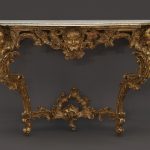
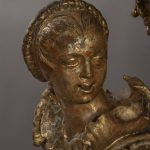
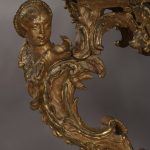

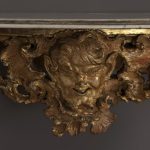
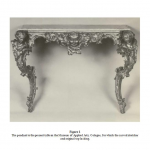
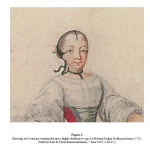
Comments are closed.